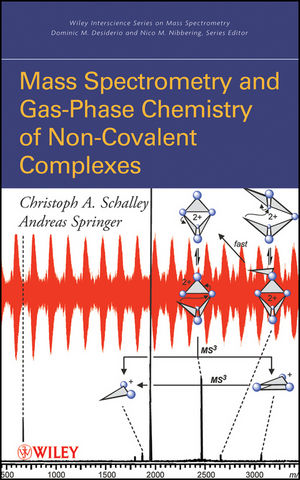Mass Spectrometry of Non-Covalent Complexes: Supramolecular Chemistry in the Gas PhaseISBN: 978-0-470-13115-2
Hardcover
592 pages
September 2009
 |
||||||
List of Tutorials.
PART A: GENERAL ISSUES.
1. INTRODUCTION.
2. SUPRAMOLECULAR CHEMISTRY: SOME BACKGROUND.
2.1. The Nature of Non-Covalent Interactions.
2.2. Classical Building Blocks in Supramolecular Chemistry.
2.3. Key Areas and Key Concepts in Supramolecular Chemistry.
2.4. Biomolecules: Intra- and Intermolecular Non-Covalent Bonds.
References.
3 MASS SPECTROMETRY FOR THE EXAMINATION OF NON-COVALENT COMPLEXES.
3.1. Common Mass Spectrometric Instrumentation for the Examination of Non-Covalent Bonds.
3.2. How Non-Covalent Bonds Change on the Transition from Solution to the Gas Phase.
3.3. Ion Energetics Issues.
3.4. Tandem-MS-Experiments.
3.5. Potential Sources of Error or Misinterpretation.
References.
PART B: ARTIFICIAL SUPRAMOLECULAR SYSTEMS.
4 FUNDAMENTAL STUDIES ON SMALLER NON-COVALENT COMPLEXES.
4.1. Ion Neutral Complexes.
4.2. High-Pressure Mass Spectrometry: Bridging the Gap Between Gas and Condensed Phase.
References.
5 DETERMINATION OF THE "SECONDARY STRUCTURE" OF SUPRAMOLECULES BY MASS SPECTROMETRY.
5.1. Mechanically Interlocked Molecules and Their Precursors.
5.2. Guest Encapsulation.
5.3. Gas-Phase Conformations.
5.4. Zwitterions and Salt-Bridges.
References.
6 CHIRAL RECOGNITION.
6.1. Tartrate Clusters.
6.2. Chiral Crown Ether-Ammonium Complexes: The Three-Point Model.
6.3. Cyclodextrin-Amino Acid Recognition.
6.4. Chiral Recognition in Amino Acid Clusters.
6.5. Homochiral Serine Octamers.
6.6. Resonant Two Photon Ionization Studies of Chiral Complexes: Spectroscopy of Diastereomeric Complexes in the Gas Phase.
References.
7 MONITORING SOLUTION REACTIVITY OF NON-COVALENT COMPLEXES BY MASS SPECTROMETRY.
7.1. Mass Spectrometric Characterization of Metallo-Supramolecular Aggregates.
7.2. Simple Ligand Exchanges in Metallo-Supramolecular Squares.
7.3. Titration Experiments with Helicates.
7.4. Helicates Again: Mechanistic Insight into Ligand Exchange Reactions.
7.5. Titration Experiments with Self-Sorting Tetraurea-Calixarenes.
7.6. Self-Sorting Reactions of Pseudorotaxane Assemblies.
7.7. Shorter Time-Scales: A Mixed-Flow Technique Applied to Self-Assembly.
References.
8. GAS-PHASE REACTIVITY OF SUPRAMOLECULES.
8.1. Molecular "Mouse Traps": Covalent Bond Formation Within Non-Covalent Complexes.
8.2. Fragmentation of Metallo-Supramolecular Helicates, Squares, and Cages.
8.3. Host-Guest Chemistry of Dendrimers in the Gas Phase.
8.4. H/D Exchange Reactions in Gaseous Non-Covalent Complexes.
References.
9 DETERMINATION OF THERMOCHEMICAL DATA.
9.1. Crown Ether Binding Affinities in Solution.
9.2. Ranking of Anion-Cavitand Gas-Phase Binding Energies.
9.3. Crown Ether-Ammonium Ion Complexes in the Gas Phase.
9.4. Crown Ether-Alkali Metal Ion Complexes and the Best-Fit Model.
References.
PART C NON-COVALENT COMPLEXES OF BIOMOLECULES.
10 NON-COVALENT COMPLEXES WITH PETIDES AND PROTEINS.
10.1. Metal-Ion Binding to Peptides and Small Proteins.
10.2. Probing Three-Dimensional Protein Structure and Protein-Protein Interactions.
10.3. Interactions of Proteins with Small Molecules.
10.4. Sugar-Peptide and Sugar-Protein Complexes.
10.5. Interactions of Proteins with Oligonucleotides, DNA, and RNA.
References.
11. NON-COVALENT COMPLEXES OF NUCLEOTIDES.
11.1. Metal-Ion Binding to DNA Bases and Oligonucleotides.
11.2. Are Watson-Crick Base Pairing and Double Helix Conserved in the Gas Phase?
11.3. G-Quartets.
11.4. The Folding of G-Rich Strands into Quadruplexes.
11.5. Minor Groove Binders and Intercalators: The Binding to Duplexes.
11.6. Non-Covalent Interactions With G-Quadruplexes.
References.
12. CARBOHYDRATES.
12.1 Carbohydrates: Their Importance and Analysis.
12.2. Stereodifferentiation of Small Carbohydrates.
12.3. Structural Aspects of Oligosaccharides by MS and IMS.
12.4. Carbohydrate Association.
12.5. Summary and Outlook.
References.
13. EPILOGUE.
Index.



